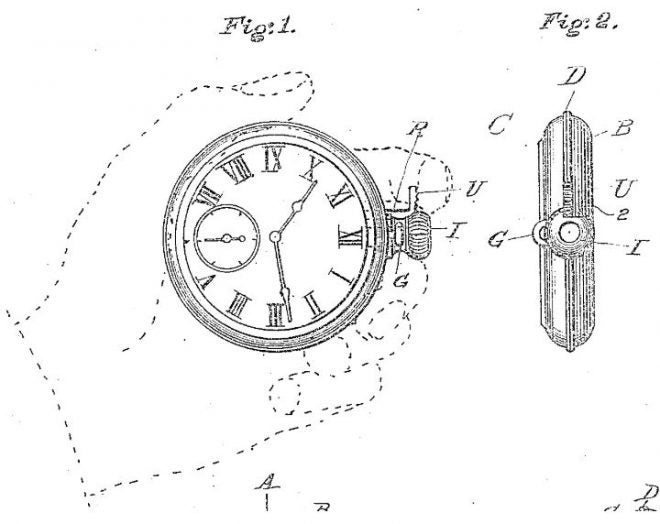“Hand over your watch!” Why certainly, Mr. Burglar. That’s the headline for an article in Popular Science magazine from December 1917. It’s proofed that some things never change, even after 101 years. If you’re approached by a mugger and you’ve got a nice watch, he’s going to want it. Leonard Woods of St. Louis, MO, knew this, so he designed a pocket watch with some firepower inside of it.
Concealed Carry Corner: Watches, Cards And Phones – Discreet Carry
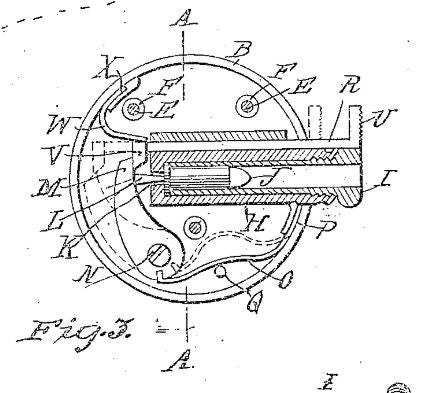
Leonard Woods’ first watch design
Mr. Woods applied for a patent on November 4, 1912, for what was essentially a derringer watch. That is, a single-shot pistol concealed within a pocket watch. On September 16, 1913, he received patent #1,073,312 from the US Government.
In his application, Woods explained the idea behind his design:
“The object of my invention is to provide a pistol that can be carried in the vest pocket like a watch, is as readily accessible, and appears like a watch, whereby it may be presented and fired at a highwayman while apparently merely obeying his command to ‘hand over your watch and be quick about it!'”
It only took a few months before Leonard Woods realized that one round of .22 rimfire might not get the job done. So, on January 19, 1914, he applied for another patent on an improved design. More than a year and a half later, he received approval in August 1915.
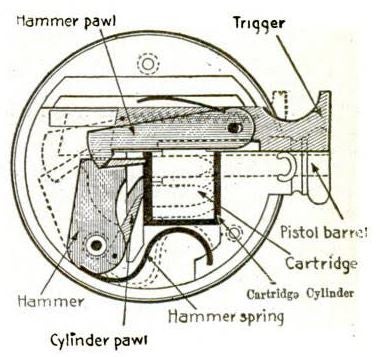
Woods’ revolver watch
His new design concealed a diminutive seven-shot revolver inside the case of the pocket watch. Woods’ ability to create something so small that actually worked within the already cramped confines of a watch case is quite an achievement. Unfortunately, space constraints meant that the pistol packed very little punch.
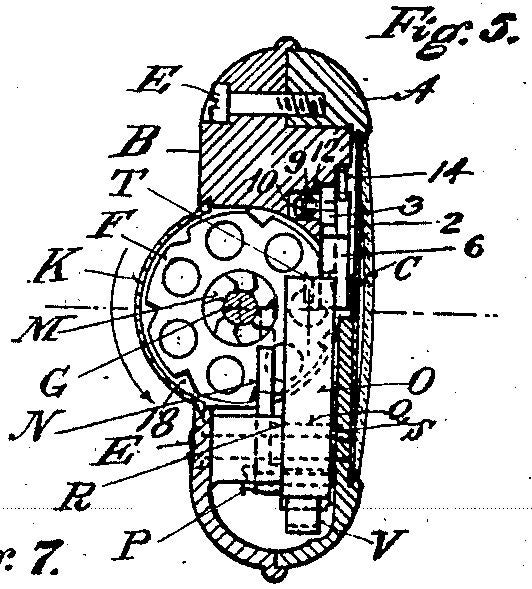
Looking down the barrel of the patent drawing
The watch stem doubles as the barrel. A small trigger slides along the stem, allowing for perfect ergonomic placement in the hand.
Popular Science described how a mugging scene might play out if the assailant came upon a victim armed with this pocket watch pistol of Mr. Woods’ design:
“As you pretend to be looking at the time, you are actually aiming at the hard heart in front of you. If the thief insists upon having the use of your watch, you can give it to him by simply pressing the trigger.”
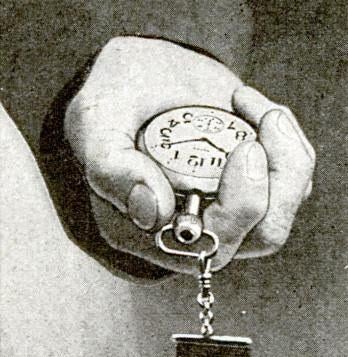
Illustration from Popular Science
Lewis Winant’s awesome 1955 book, Firearms Curiosa, features the gun’s patent drawing on the cover. Winant discusses Woods’ design in the book. I highly recommend picking up a copy because there are plenty of other amazing and unusual concepts within its pages. It definitely lives up to the title!
Despite the ingenuity, Woods’ invention caught on. The only one similar that I know of is a British design of which very little is known. I am, however, familiar with a modern-day design that is very similar.
Engraver and jeweler Andreas Von Zadora Gerlof removed the internals of a pocket watch and fitted it with the mechanism necessary to fire tiny .22 CB rounds. Even though it doesn’t keep time, it’s still right twice a day. If that’s something you’re interested in, there’s one for sale over at AZFirearms.
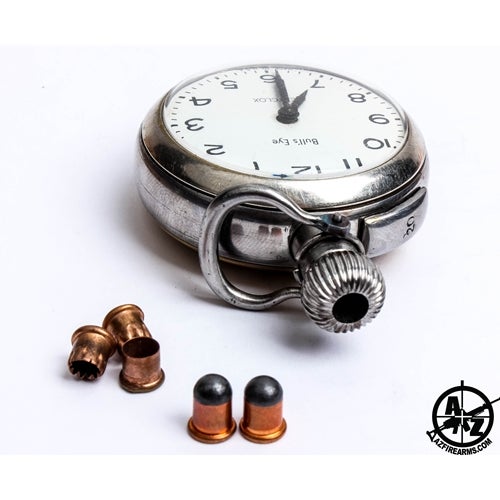
Gerlof’s modern version
It’s been more than 100 years since Leonard Woods cooked up the idea of a pocket watch pistol. Even though his design didn’t take off, it lives on in spirit. There are some modern “disguised” guns available to today’s consumer.
First up is the LifeCard, which is a single-shot .22LR firearm that isn’t much larger than a handful of credit cards stacked on top of one another. Weighing just 7 ounces and only half an inch thick, it fits perfectly in the watch pocket on your jeans (Mr. Woods would be proud).
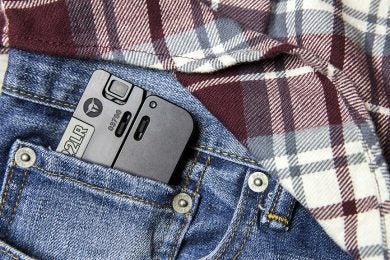
LifeCard in the watch pocket
Another similarly-sized option is the Ideal Conceal pistol. Very similar in design to the LifeCard, the Ideal Conceal will pack more punch since it is chambered for the .380ACP cartridge and is a double-derringer configuration. It’s also a bit larger; while the LifeCard can fit in an Altoids tin, Ideal Conceal is about the size of your average smartphone.
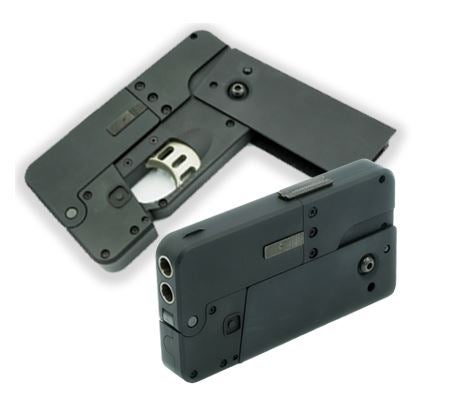
Ideal Conceal’s .380 double derringer
Kicking it up a notch are the offerings from Full Conceal. Their M3D is built on the Glock 19 and their M3S is built on the Glock 43. The concept behind these pistols is that when they are folded up and placed in your pocket, the outline looks like a wallet or cell phone. The benefit to these models over the LifeCard or Ideal Conceal is magazine capacity and caliber size. The M3D has a capacity of 21+1 and the M3S is 8+1.
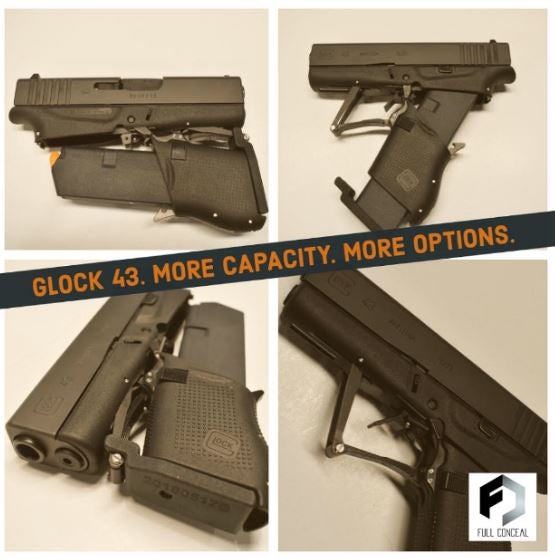
Full Conceal’s M3S model
When Leonard Woods designed his pocket watch pistol, there were already myriad diminutive designs of larger caliber and higher capacity available to the discerning gentleman or safety-conscious lady. No doubt, that is why the design is relegated to history.
With so many highly-effective, conventional-looking pocket pistols for sale today, is there really a solid market for guns such as the LifeCard, Ideal Conceal, and Full Conceal? Or will they soon go the way of the pocket watch pistol – lost to time until some writer in the future stumbles upon their patents in a book or on a website and writes another piece like this in 2118?
TFB’s Concealed Carry Corner is brought to you by GLOCK

 Your Privacy Choices
Your Privacy Choices
